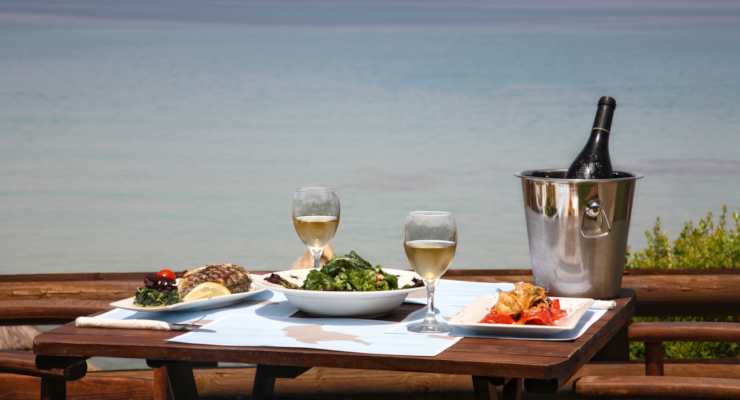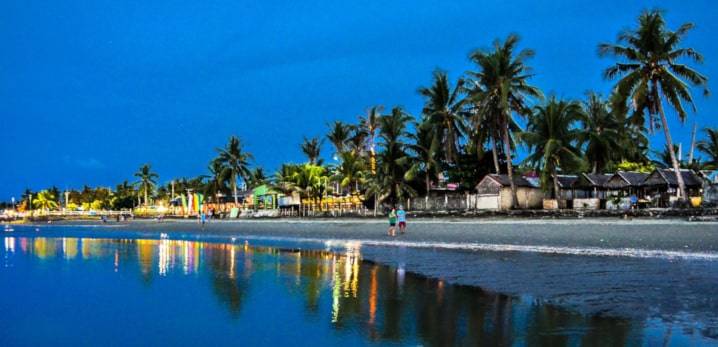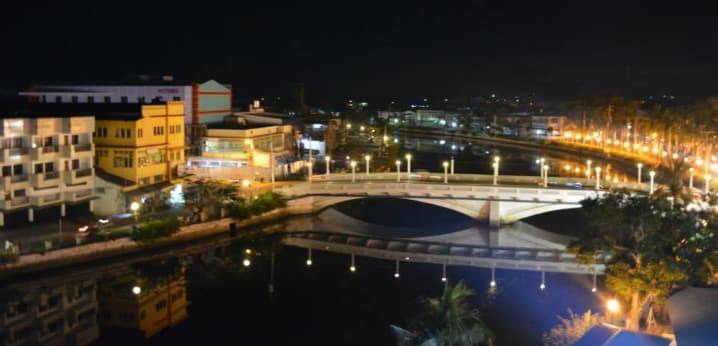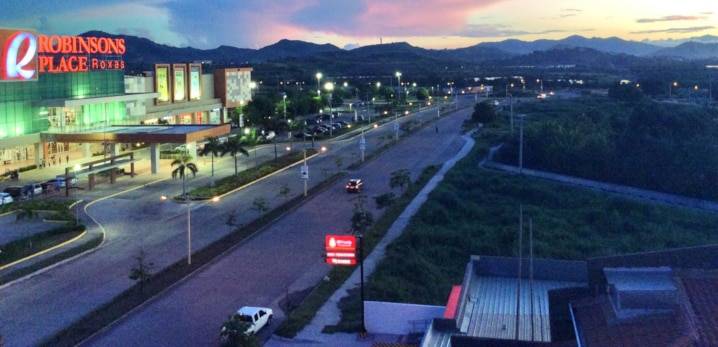
As you may already know, the cost of living in the Philippines is famously affordable. You can live like a local (or a smart expat) without burning through your savings. The truth is, if you choose the right city, you can enjoy life in a bustling urban hub for as little as $1,000 a month. But here’s the real secret: if you pick a medium-sized city like Roxas City, you could live comfortably for just $600 a month and still have enough left over for dessert… or maybe an extra kilo of shrimp.
Located in Capiz province on Panay Island, Roxas City is the chill cousin of Iloilo—less traffic, fewer crowds, but still big on essentials like education, trade, and economic activity. With a population of around 167,000, it’s just the right size: not too sleepy, not too overwhelming, kind of like the Goldilocks of Visayan cities.
And if you’re a seafood lover, prepare to fall in love faster than you can say “Diwal.” Dubbed the “Seafood Capital of the Philippines,” Roxas City is basically heaven for your taste buds. Think crabs, scallops, milkfish, oysters, and shrimp, all fresh, all delicious, and none of them costing an arm and a leg. You’ll probably eat so well here, your cholesterol might send you a polite warning letter.
So if you’re after affordable living, a peaceful coastal lifestyle, and daily seafood feasts that make your Instagram followers jealous, Roxas City just might be the best-kept secret in the Philippines.
Table of Contents
- The Level of Comfort You Can Expect
- The Best Locations to Settle Down in Roxas, Capiz
- Cost of Living in Roxas City in Peso
- Cost of Living in Roxas City in US Dollars
- Pros & Cons of Living in Roxas City
The Level of Comfort You Can Expect
So, what’s the real cost of living in Roxas City? Great question! Whether you’re balling on a budget or living like a low-key king, Roxas has a lifestyle tier just for you. To make things easier (and a bit more entertaining), here’s a quick breakdown of the local social classes and the level of comfort you can expect, minus the fluff and with just the right amount of rice.
Think of it like a menu: from the “I’m just here for peace and pancit” crowd to the “I want aircon, Wi-Fi, and seafood delivered to my beachfront balcony” types. No matter where you land, one thing’s for sure—living in Roxas City won’t break the bank, but it might spoil you for anywhere else.
Here’s a summary of the social classes and the level of comfort you will experience living here:
- Php 20,000 ($400) is possible but not very comfortable. This is the current low-income class (but not poor) in the Philippines.
- Php 38,000 ($760) is comfortable. This is the lower-middle-income class.
- Php 67,000 ($1,340) is very comfortable. This is the middle-income class.
- Over Php 67,000, and you will live nicely here in Roxas City.

The Best Locations to Settle Down in Roxas, Capiz
Roxas City may be classified as a medium-sized city, but let’s be honest, it’s compact enough that you can get from one end to the other faster than it takes to finish your taho. No matter where you live, chances are you’re just a tricycle ride away from your next errand, meal, or beach selfie.
Traffic? Barely. Stress? Optional. Everything feels conveniently close, which means less commuting and more time for things that matter, like eating seafood or watching the sunset without sweating through your shirt.
Now, if you’re wondering where to plant roots and call it forever bahay, don’t worry, we’ve done the legwork (and the occasional chismis-checking) for you. We’ve identified the top 3 best locations in Roxas City where you can build or buy a permanent residence.
Whether you’re after peaceful vibes, strategic access to schools and markets, or simply want neighbors who don’t blast karaoke at 2 a.m. (no promises though), we’ve got you covered.

Location #1: Near Baybay Beach
Baybay might just be Roxas City’s best-kept secret, except it’s not really a secret anymore, because most of the foreign nationals we’ve met have already claimed it as their personal paradise. And honestly, we can’t blame them. It’s quiet, breezy, and relaxing, like nature itself is whispering, “retire here, my friend.” The weather behaves almost all year round (no melting heatwaves or dramatic typhoons most days), making it the perfect backdrop for morning walks or afternoon hammock naps.
Did we mention Baybay Beach? It’s not just a beach; it’s the 15th largest natural bay in the world. That’s right, world. Not barangay. Not a province. World. It’s swimming with marine life, so if you love seafood, you’re basically living next to the ocean’s buffet table. Think crabs, oysters, shrimp, and scallops—the entire cast of a seafood mukbang video.
Baybay is also home to famous beach resorts, peaceful residential communities, and enough grilled seafood stalls to make you question why you ever cooked at home. And if you need to run city errands or want a taste of the urban hustle, the city proper is just 10 minutes away (that’s 7 km, or three tricycle chismis stories long).
Oh, and just to sweeten the deal: SM Mall Roxas is just nearby, a 10-hectare mega mall that promises the same vibe as SM Iloilo but with more space to get lost in. So yes, Baybay has everything: ocean breeze, quiet charm, sizzling seafood, and a mall big enough to forget why you came in the first place.

Location #2: City Proper
Living in the city proper of Roxas City is like having a front-row seat to everything the city has to offer, without the usual chaos and car horns of big-city life. You’re close to it all: banks, malls, universities, gyms (you know, for that membership you might actually use), and of course, endless food options when cooking just feels like too much commitment. And if you’re into business, you’re in luck. Being in the heart of the city means your commute is basically just a long blink.
Surprisingly, despite being the city’s center, it’s still wonderfully peaceful. No constant blaring sirens or 4 a.m. traffic jams here. The truth is, Roxas City’s downtown feels more like a well-behaved cousin of the usual noisy urban sprawl. There’s less air pollution, more friendly faces, and the occasional neighbor who still knows your name, and probably your merienda schedule, too.
There are still plenty of residential areas (and yes, vacant lots!) tucked within the city proper, so you won’t have to battle for breathing space. It’s the kind of place where you can sip your morning kape in peace and be at the bank, the wet market, and your kid’s school all before noon, without needing three different transportation apps.
In short: if you want city convenience without city chaos, Roxas City proper might just be your perfect blend of hustle and hush.

Location #3: Pueblo de Panay
Pueblo de Panay is Roxas City’s answer to “What if we built a mini-country inside the city?” This 500-hectare township has it all—commercial hubs, tourism spots, a church, residential areas, and just enough modern flair to make you occasionally forget you’re still in Capiz and not some upscale suburb abroad. Honestly, the vibe here is so chill and put-together, you might catch yourself speaking in a slight foreign accent while ordering pancit.
With its laid-back ambiance and everything practically within walking (or golf cart) distance, you really can’t go wrong living here. Pueblo de Panay is home to Roxas City’s Public Transportation Terminal, the city police station (which means extra peace of mind), a reputable school, cozy residential communities, hotels, car dealerships, restaurants, and, of course, Robinsons Place, the go-to mall for shopping, snacking, and pretending you’re just “window-shopping” before coming home with three new shirts and a blender you didn’t plan to buy.
And if you’re into business? Even better. This place is a goldmine of opportunity. It’s well-planned, highly accessible, and full of foot traffic (the good kind, not the “Metro Manila-style” kind). Pueblo de Panay is perfect for entrepreneurs, professionals, or anyone who wants to live in style without the downtown noise or, let’s be honest, the tricycle karaoke battles.
In short, if you want a neighborhood that feels like it came out of a brochure but still serves bangus for breakfast, Pueblo de Panay is the place to be.
Cost of Living in Roxas City in Peso
- Apartment/House: Between Php 6,000 and Php 20,000 per month
- Transportation (per ride): Php 15
- Cost per regular meal: Around Php 100, but if you cook your own meal, you can save around 50% of the cost.
- Basic Utilities (electricity, water, and garbage): Between Php 2,000 and Php 3,000 per month
- Internet: Between Php 1,000 and Php 2,000 per month
- Smartphone services: Between Php 300 and Php 1,000 per month
- Fitness Club Fee: Between Php 600 and Php 1,500 per month, but you have an option to use the sports complex of Roxas City – the Villareal Stadium – at Php 10 per visit.

Cost of Living in Roxas City in US Dollars
- Apartment/House: Between $120 and $400 per month
- Transportation (per ride): 3 cents
- Cost per regular meal: Around $2, but you can save around 50% of the cost if you cook your own meal.
- Basic Utilities (electricity, water, and garbage): Between $40 and $60 per month
- Internet: Between $20 and $40 per month
- Smartphone services: Between $6 and $20 per month
- Fitness Club Fee: Between $12 and $30 per month, but you have an option to use the sports complex of Roxas City – the Villareal Stadium – at 2 cents per visit.
Pros & Cons of Living in Roxas City
Here are some pros and cons of living in Roxas City:
Pros
1. Abundant Supply of Seafood
If you’re a seafood lover, welcome home because you’ve just found your happy place. In Roxas City, seafood isn’t a luxury; it’s a lifestyle. Fish, shrimp, crabs, oysters, scallops, you name it, it probably came straight from the ocean this morning and landed on someone’s grill by lunch. And the best part? It won’t burn a hole in your wallet. You can feast like royalty on a fisherman’s budget.
But don’t worry if you occasionally crave something other than what swims, crawls, or has shells. Other local dishes are just as affordable, delicious, and likely cooked with love (and a questionable amount of garlic). Whether it’s a hearty bowl of batchoy, a sizzling plate of sisig, or a good ol’ chicken inasal, Roxas delivers on both flavor and price.
So yes, if your stomach speaks fluent seafood, and doesn’t mind a few cheat days with local comfort food, Roxas City is basically your edible dream come true.
2. Low Pollution
With 53% of Roxas City’s economic activity coming from farming and fishing, the vibe here is more “fresh catch and rice fields” than “factory smoke and traffic fumes.” That means the air is cleaner, the skies are bluer, and your lungs can finally take a deep breath without questioning your life choices.
Unlike the bigger cities where the pollution levels can make you feel like you’re smoking a cigarette just by walking outside, Roxas keeps things refreshingly low-key. The only thing you’ll be inhaling here is the smell of grilled bangus, freshly plowed soil, and maybe the occasional sea breeze (which we count as free therapy).
So yes, we grow food, catch fish, and breathe better, all while avoiding the smog and stress of big-city life.
3. Longer Days
If your current lifestyle feels like a never-ending episode of “Survivor: Urban Edition,” then Roxas City might just be your happily-ever-after in flip-flops. Here, the stress melts faster than ice cream on a sunny afternoon, and even Mondays feel like they’re just politely passing by.
The days somehow feel longer (maybe it’s the slower pace, or maybe it’s just the fresh seafood slowing time down), and life is just… easier. People aren’t in a rush, the traffic doesn’t require deep breathing exercises, and you’ll probably forget what the word “commute” even means.
So if you’re looking for a place where your blood pressure can finally take a vacation, and maybe you can too, Roxas City is your lifelong break from the noise, chaos, and overpriced lattes.
4. Shopping Malls and Restaurants
Roxas City may be laid-back, but it’s no slouch when it comes to shopping and eating your way through life. With at least six shopping malls (yes, six, and no, you don’t need to visit all of them in one day unless you’re training for a retail marathon), you’ll have plenty of places to spend, splurge, or just pretend you’re “window-shopping.”
And when it comes to food? Get your taste buds a passport. The city serves up a full international buffet without needing a visa. From Filipino classics to American burgers, Japanese sushi, Korean BBQ, Chinese dim sum, Indian curries, and even Mexican tacos—Roxas City basically said, “Why travel the world when you can just eat it?”
Whether you’re craving sinigang or samosas, burritos or bibimbap, chances are you’ll find it here—and at prices that won’t leave your wallet gasping for air.
5. Friendly Residents (and English-speaking too)
The people of Roxas City are some of the friendliest you’ll ever meet. We smile a lot, we wave even if we just met you five seconds ago, and yes, we’ll probably offer you food before you can even sit down. We’re also polite, helpful, and genuinely curious about where you’re from (so be ready to answer “Where are you from?” at least three times a day).
And don’t worry about getting lost in translation because we speak English too! Maybe not with a Hollywood accent, but enough to give directions, share a good laugh, or help you find the nearest place to eat halo-halo. So, whether you need help finding a jeepney or just someone to chat with while waiting for your seafood order, you’ll never feel like a stranger here; just a new friend we haven’t fed yet.
Cons
1. Major Means of Public Transportation
While most foreign nationals are delighted (and slightly confused) by our beloved tricycle, a motorcycle with a sidecar that defies physics and personal space, you might find it less charming after your third bumpy ride through town with your knees glued to your ears. It’s great for short trips and quick errands, but let’s be real: tricycles weren’t exactly designed for long-legged comfort or grand grocery hauls.
Sure, we also have jeepneys and buses cruising around the city, adding that colorful, chaotic flair to the streets, but if you’re planning to stick around and live the good life in Roxas, having your own car is the real power move. You’ll have more space, more comfort, and the freedom to blast your playlist without negotiating legroom with a stranger and a sack of rice.
So while the tricycle is a cultural gem (and practically a rite of passage), owning a car gives you VIP status in the world of Roxas commuting, and possibly fewer chiropractic visits.
2. No Large Amusement Parks
Sure, we’ve got shopping malls that can keep you entertained for hours (or until your feet give up), but if you’re looking for massive roller coasters and theme parks that launch you into the stratosphere, well, Roxas City isn’t quite there yet. We don’t have Disneyland-level thrills, but hey, who needs a giant loop-de-loop when you’ve got fresh air, scenic views, and zero entrance fees?
Outdoor fun here comes in the form of beaches, riverside strolls, seafood feasts by the shore, and spontaneous karaoke battles (which, let’s be honest, are way more exciting than any haunted house ride). So while you won’t find giant mascots or overpriced popcorn, you’ll definitely find peace, sunshine, and enough grilled bangus to make you forget you ever wanted a Ferris wheel.
3. Limited Housekeeping Services
Housekeeping services in Roxas City won’t cost you an arm and a leg, more like a couple of hundred pesos and maybe a snack. But while the price is friendly, availability can be a bit like spotting a rare Pokémon. They’re around, just not always when you need them most (like right after you’ve hosted a seafood feast and your kitchen looks like a war zone).
So don’t be surprised if you end up channeling your inner Cinderella, minus the singing mice, and handling the chores yourself. On the bright side, mopping your floor in flip-flops totally counts as cardio.
Final Thoughts on the Cost of Living in Roxas City
The cost of living in Roxas City is refreshingly low, so low that your wallet might start relaxing the moment you arrive. While you won’t see towering skyscrapers or dramatic skylines here (no nosebleed floors, promise), you also won’t feel the overwhelming pressure that comes with life in a noisy, traffic-choked megacity. Roxas is more “Sunday afternoon nap” than “Monday morning rush hour,” and honestly, that’s part of its charm.
Getting around is also a breeze. Thanks to well-connected roads and minimal congestion, it’s pretty hard to get lost here unless you’re distracted by the smell of seafood grilling somewhere (which, to be fair, happens often).
Now, if you find yourself falling in love with the chill vibe, the fresh air, or the fact that people here still say good morning to strangers, you might want to stick around for the long haul. And guess what? You totally can. Land in Roxas City starts at just ₱7,000 per square meter (around $140), which is basically a steal compared to prices in Manila or Cebu, where you need a small fortune just to afford a parking spot.
Once you’ve secured your little slice of paradise, you can build a decent-sized home for as low as ₱1.4 million (about $28,000). That’s it! No more bleeding cash on monthly rent. Just imagine: you, in your own home, drinking kapeng barako on your own porch, while your city friends are still figuring out how to afford a 15-square-meter condo with zero windows.
So if you’re tired of paying rent that feels like a bad life decision, Roxas City is ready to hand you the keys to a simpler, saner, and seafood-filled life.
You may also like:
Frequently Asked Questions
How many people live in the Philippines?
The Philippines had a whopping 109,581,078 people in 2020, which means you’re never really alone here, especially in traffic. That’s a 1.35% increase from the previous year, or as we like to call it: a few more karaoke-loving, rice-eating humans joining the fun.
But don’t worry because Roxas City keeps it cozy. With a population of only around 167,000, it feels more like a big, laid-back neighborhood than a crowded metropolis. You can actually walk down the street without playing human Tetris, and there’s a good chance your tricycle driver knows your cousin. Or your dog. Or both.
So if you’re into peace, space, and friendly faces that don’t come in millions, Roxas is the perfect low-key retreat in a very lively country.
How much does it cost to live in the Philippines?
On average, living in a big city in the Philippines will cost you around $1,000 a month, which isn’t too bad until you realize half of that goes to rent, traffic-induced snacks, and overpriced coffee you didn’t really need. But if you choose a medium-sized city like Roxas, guess what? You can save up to 40% of that amount, and still live comfortably, eat like royalty, and have enough left over for lechon on the weekends.
It’s like getting the same fun Filipino lifestyle, just with more fresh air, fewer honking horns, and a much happier wallet. Plus, with all that extra savings, you might even start thinking you’re rich until your relatives find out and start sending you “pa-birthday” requests.
Can a US citizen live in the Philippines?
Yes, you can own property in the Philippines, but with a small plot twist. If you’re married to a natural-born Filipino (lucky you!), you can own up to 5,000 square meters of urban residential land. That’s enough space for a house, a garden, a couple of mango trees, and maybe even a pet goat named Gary.
If you’re flying solo or not married to a Filipino citizen, you can still own a vertical slice of paradise, a.k.a. a condo. And don’t worry, condos here aren’t just boxes in the sky. Many of them come with pools, gyms, 24/7 security, and sometimes even a karaoke room (because, you know, priorities).
So whether you’re grounded on land or living the vertical life, you’ll still feel right at home here, with or without mangoes and goats.
What is the cheapest place to live in the Philippines?
If you’re working with a tight budget, the kind where your wallet wheezes every time you open it, then a smaller city might just be your financial soulmate in the Philippines. Skip the flashy metropolises and pick the right spot, and you could be living a surprisingly comfortable life for around $600 a month. Yes, really. That’s rent, food, utilities, and still enough left over for the occasional halo-halo or beach trip.
It’s like the Philippines’ way of saying, “Who needs stress and sky-high prices when you can have peace, pancit, and change in your pocket?” So if you’re tired of watching your monthly expenses behave like they’re training for a marathon, downsizing to a smaller city might just be your smartest move yet. Your bank account will thank you, and so will your blood pressure.






